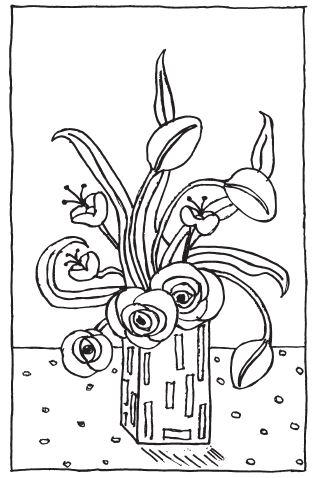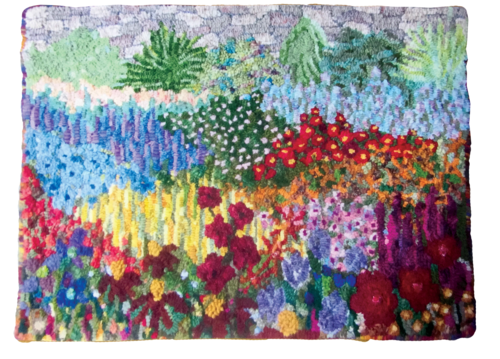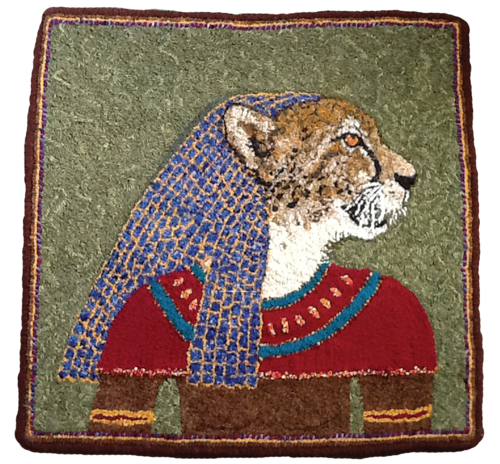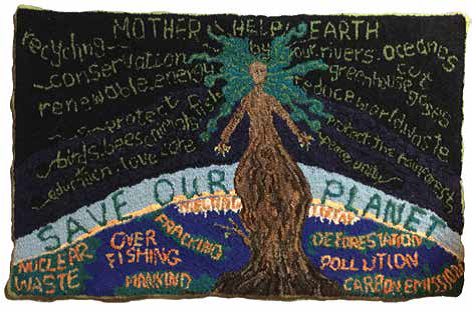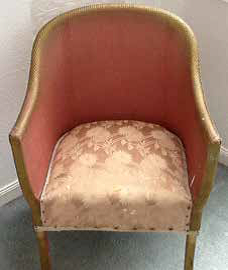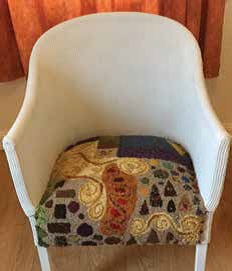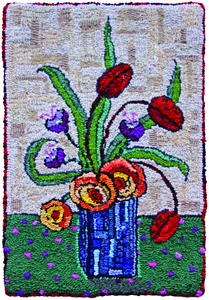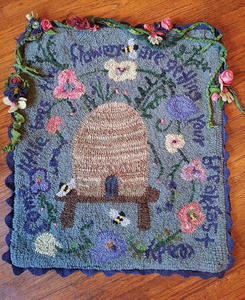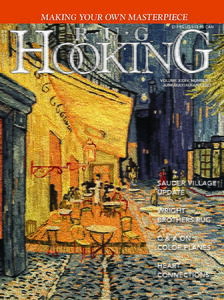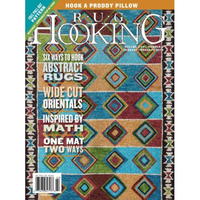Rug Hooking in the Scottish Highlands
Inspirations from the land
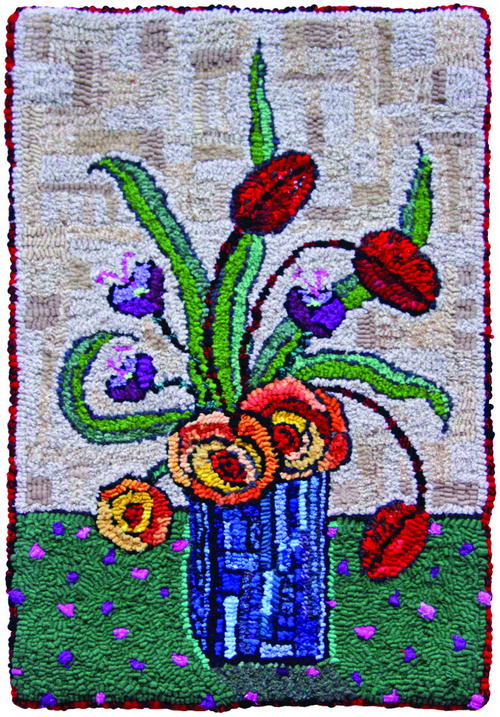
Flowers in Vase , 14" x 20", #4-, 5-, and 6-cut wool on linen. Designed and hooked by Brigitte Webb, Dingwall, Scotland, 2015.
I admire the art of Charles Rennie Mackintosh, a Scottish architect, designer, water colorist, and artist. This rug is my tribute to him. Some work is governed by what is found in my stash, particularly as most of what I use is imported from America and Canada. This rug was determined by the size of a piece of backing material I had left over. I often draw directly on my backing, as any mistakes will be covered up with my hooking.
LESSON: Be open to helpful, constructive advice and don’t be afraid to change things if it feels right.
People ask what inspires me to hook and design a rug. The answer is as varied as life itself. Almost anything can and does inspire me—the color of the fields, trees, and mountains; a memory; seasons; wools gathered or gifted; and other artists’ and rug hookers’ work. Here in the Scottish Highlands, I am never short of inspiration.
Needless to say, I am influenced by the magnificent highlands of Scotland where I live. This rug is my tribute to the work of artist Charles Rennie Mackintosh. I find his work to be beautifully stylized, with a wonderfully deceptive simplicity, often featuring flowers and geometric elements. I wanted to create my own design that would be recognized as being influenced by him, but in no way copied. Most of my designs are drawn directly onto my backing material, but in this instance, I drew freehand onto red dot, then transferred onto linen. I confess I did make alterations as I hooked from the first draft pattern.
I admire people that color plan their work before they start, but I am not one of them. I use my stash, choosing colors, textures, and shades that I have on hand. I am not afraid to change my mind or take out something that does not work for me.
This is how I hooked my version. Adapt your colors and hooking techniques to suit your own vision.
1. Tulips: The tulips in this piece were a good place for me to start, as I love reds. In keeping with my Scottish theme, I used plaids and tartans in these flowers.
2. Roses: I originally hooked the roses in a bright purple, but on advice from Susan Feller, who pointed out that the values were too close to other elements and did not have enough contrast, I changed them to hand-dyed orange spot wools.
3. Other flowers: The smaller flowers gave me the chance to use some hand dyed purple wools.
4. Outlines: Mackintosh used strong outlines in his work, so I followed his lead and used dark greens for the leaf outlines, a mixture of dark greys and dull blacks for the flowers, and navy for the vase. I did this partly to stay true to his designs, but largely to make this design pop.
5. Vase: I hooked the simple vase shape in shades of blue spot-dyed wool to compliment the orange roses. As I hooked the vase I noticed it had no depth, so I added a bit on one side to make it more three dimensional. I hooked horizontally for strength and to direct the eyes to the flowers. It is reminiscent of hit-or-miss style, but in this case I hooked horizontally to make it look more geometric.
6. Background: I did not want to detract from or overshadow the simple floral elements with the background. Since I hooked the vase in a geometric Mackintosh style, I used a subtle repeat of that design in light soft beiges and tans. I did not draw in the background sections; I hooked in a semi-random manner, as I looked ahead and visually planned each section. My large selection of close values of wool allowed me to choose values that sat well next to each other. I kept the block shapes and sizes in mind, creating balance as I worked. This is a nod to Charles Rennie Mackintosh, as he often used shapes and colors in a similar fashion. It works well because of the subtle changes in the color shades, and this faux geometric background acts as a foil to the vase. The background is my favorite part of the design.
7. Tablecloth: The tablecloth echoes the leaves, adding weight and grounding to the vase of flowers. The dots in the design pick up colors in the flowers. I used a duller green to create a bit of a grounding shadow where the vase sits on the tablecloth.
8. Beaded edge: I hooked a beaded edge, used a combination of a plain red and a red plaid (my Scottish influence again!), repeating the reds of the roses.
Incorporating the red plaid with a similar red fabric makes the beading much more subtle than it would be with a different color choice. This beading treatment created a unity to this design.
HOW TO ADD A BEADED BORDER
1. Start with two strips of wool in different colors or textures. In this design, I used a #8-cut plain red and a strong red plaid for the beading.
2. Bring the two strips up together, through the same hole in the backing, to the top of your design.
3. Beneath the backing, hold the two strips of wool in one hand; hold your hook in other hand above the backing.
4. Stick your hook through the backing where you want to begin the beading line.
5. Pick up and place first color onto hook. Pull it up through the backing, creating the first loop.
6. Under your backing, drop this wool strip and pick up the other color. Place this second strip on your hook and pull it up to create a loop.
7. Repeat this process, alternating the colors so you get a boxed or beaded effect.
8. When a strip runs out, bring the end to top of the rug and pull the end of a new strip of that color to top, through the same hole, and proceed as before.
See two more of Brigitte’s hookings inspired by her gardens and love of flowers in “Torn Blooms.”
PATTERN
I Wish, 24" x 18", #3-, 4-, and 5-cut wool, silk, yarn, and roving on linen. Designed and hooked by Brigitte Webb, Dingwall, Scotland, 2012.
My love of gardens and teaching flower arranging for many years was the inspiration for this rug. Hooked directly on linen backing without any drawing, I started by hooking some flowers inside the border line at the bottom in the middle, working upwards and outwards, choosing colors and textures as I hooked. Those who know me will recognize in this piece my love of using bright and happy colors in rugs. I was pleased that this rug was chosen for Celebration.
Lesson: Be inspired by all around you. Do not be afraid to enter shows or competitions—nothing happens unless you give it a try!
-
Mafdet, 26" x 26", #3 through 6-cut wool and sari silk ribbon on rug warp. Designed and hooked by Brigitte Webb, Dingwall, Scotland, 2014.
Inspired by a family holiday to Florida and a visit to Animal Kingdom. I sought shelter from the heat for a time in a covered area with a large observational glass window overlooking the cheetah enclosure. Whilst quietly observing these magnificent cats, taking lots of photographs, I noticed that on the walls surrounding me were resin/plastic cartoonish Egyptian reliefs. Eureka moment! I knew that the cheetah was often portrayed as an Egyptian Goddess, Mafdet. So I decided to hook an Egyptian body with a realistic cheetah head, using some of my own photos as reference. I researched Mafdet, drawing a rough sketch of what I wanted based on information gathered. I sent these to Leonard Feenan, asking if he would design this for me on rug warp. Then I consulted with talented animal rug artist Judy Carter on the wool to use. She sent me a selection of wools for the cheetah’s head. Some folks may feel this is cheating to ask someone else to gather wool or color plan, but I don’t. Having an expert on call is always a help. When I receive wool from Judy my first thought is always: Oh, my goodness! What do I choose, where do I use this, and how? Living in the UK it is extremely difficult to obtain enough variety and textures for hooking realistic portraits of animals and birds. Using Judy’s book, Hooking Animals, reading and re-reading her articles in Rug Hooking magazine, I took her advice: use great visuals, hook what you see, hook in directions shown. I color planned the rest of this rug myself. I dyed colors for the headdress. Mafdet was said to be a goddess for protection, particularly against snakes, so I gave her a snake amulet. I truly loved hooking this rug. Although the original idea was mine, this really was a result of great partnerships along the road to creation.
LESSON: Never be afraid to seek advice and help with your work or in researching your subject matter. -
HOW DO YOU FIND INSPIRATION?
Here are my five key suggestions.- Hook what is meaningful and important to you.
- Be open to helpful, constructive advice and don’t be afraid to change things if it feels right.
- Never be afraid to seek advice and help with your work or researching your subject matter.
- Hook from the heart—love what you create and share it with others.
- Don’t be afraid of color—it brightens our lives.
- Be adventurous and step out of your comfort zone.
-
Geometric Rug, 21" x 39", #3- to 8-cut wool on rug warp. Designed and hooked by Brigitte Webb, Dingwall, Scotland, 2015.
I enjoy hooking a less arduous rug in between challenging ones—it allows me to relax and have thinking time for the challenge. Each square in this design is four inches in size. This rug was hooked using mostly worms (strips of wool) of different cut sizes left over from other projects. Deciding on colors and their placementwere the most thought-provoking part of this piece. This rug is draped over the back of a small settee and it brightens the darkest days.
Lesson: Don’t be afraid of color—it brightens our lives. -
Save Our Planet, 32" x 20", #3-, 5- and 6-cut wool on linen. Designed and hooked by Brigitte Webb, Dingwall, Scotland, 2016.
A local Womens’ Institute launched a group exhibit titled “Look to the Future.” This hooked rug would be one of five different crafts featured. I drew my design directly onto linen backing and hooked the rug using recycled wool, some as-is, some new wool, and some hand dyed wools. I start by hooking Mother Earth in the center, as the tree of life with roots on our planet. I strove to make the meaningful words as clear as possible. The only color planning was in my head. Our planet is so important to all living things, and this rug is a plea to all of us. During the hooking process, I photographed each day’s work, reviewing and altering the design as I progressed. This is a meaningful statement from my heart.
Lesson: Hook what is meaningful and important to you. -
Tribute To Klimt, 24" x 18"-, #4-, 6-, and 8-cut wool on linen. Designed and hooked by Brigitte Webb, Dingwall, Scotland, 2016.
An item of furniture was a great inspiration. This Lloyd Loom chair was drab and uncomfortable. I pondered for two years about what could be done to make it functional and attractive. I came up with this tribute to Klimt, whose art work I love. I removed the old cover, using it as a rough template for sizing my new covering. I drew the design directly onto the linen backing. I sprayed the chair itself with a special purpose white paint several times.
I started hooking in the center. As the work progressed, I regularly placed it on the seat area to check for sizing, color balance, and design elements. I photographed it frequently as I went to assess how it was developing. It is important to photograph your work to see clearly what is not working and what is glaringly wrong and needs to be changed. When completed, I took the chair and the hooked cover to a local upholsterer who completed the job.
Lesson: Be adventurous and step out of your comfort zone. -
I belong to a local craft group, and I found that the members were not aware of hooking rugs other than the rag rugs their granny used to make. So I started bringing my rug hooking work along. Some of the members have caught the bug and have hooked rugs of their own. To further promote our art, I have also given “show and tell” talks on rug hooking to several craft groups and demonstrated at fiber festivals.
Rug hooking is my joy and passion, bringing so many wonderful likeminded friends into my life. Whilst I do largely work on my own here in the Highlands, I am far from alone. I have a world of other fabulous rug hookers to share with, learn from, and be inspired by. There are lessons to learn and inspirations to pursue. Just love what you do and do what you love—it is a very personal journey.
Brigitte Webb lives in the Highlands of Scotland in the town of Dingwall. She began rug hooking in 2005 after her youngest son fell in love with a Nova Scotia girl and that girl’s mother, Gayle Wynn, introduced Brigitte to the craft. She has exhibited her collection of work twice, has been in Celebration, and works to spread the word about rug hooking wherever she goes.


